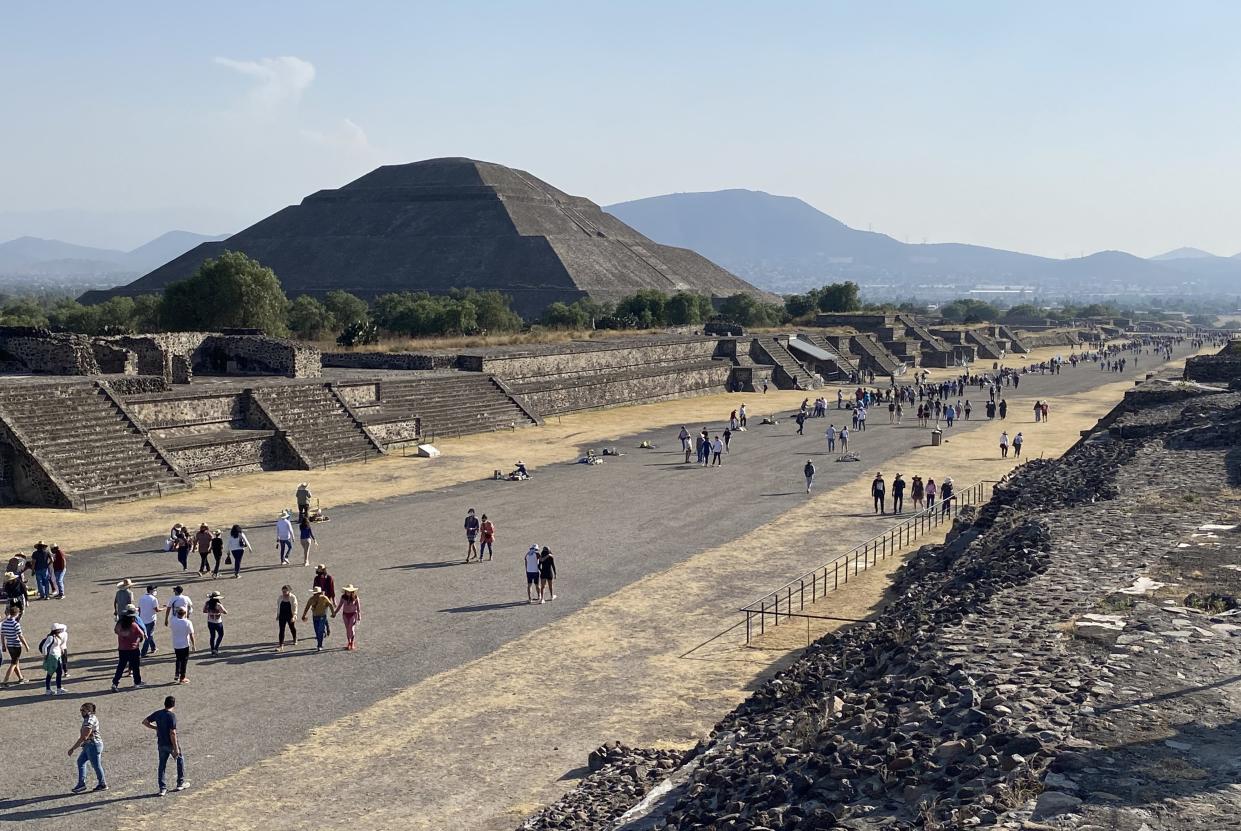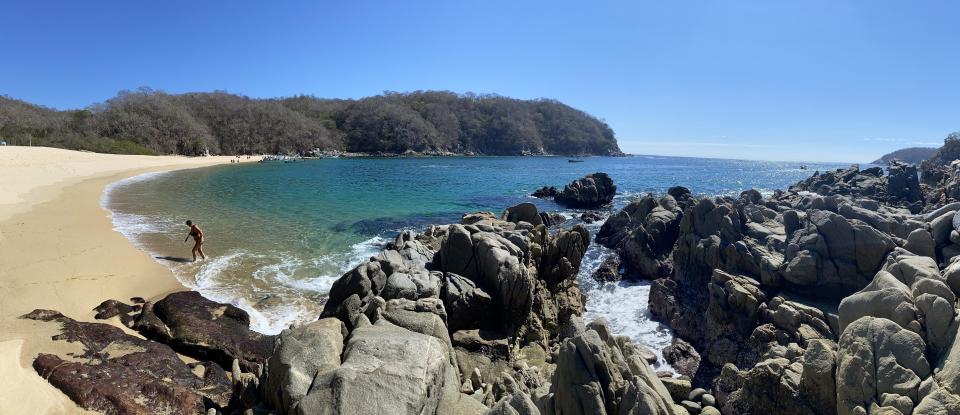Winter travel: Driving through old Mexico

If you’re eager for a sunny winter getaway in Mexico, but want to avoid the gringo glitz of Cabo and Cancun, consider touring the heart of old Mexico for two weeks in a rental car.
Be warned, driving in Mexico can be scarier than skiing black diamond slopes.
Janell and I recently drove the loop from Mexico City to Acapulco, Huatulco and Oaxaca. Along the way we stayed in city apartments, historic adobe homes, and poolside beach condos for rates that ranged from a ridiculously low $21 to a modest $75 a night. Restaurant dinners for two never topped $20, even with drinks and tips.
Everything in Mexico is cheap! Except for rental cars.
Because of poor roads and chaotic drivers, cars cost $200 a day with full insurance. We got an old, scratched Chevrolet sedan for $150 a day because we chose a policy with a $1,000 deductible, betting that we wouldn’t add new scrapes.

We faced Mexico City traffic first, and it’s the worst. Cars park in traffic lanes, red lights are mere suggestions, streets merge at all angles, and motorcycles weave everywhere. When traffic stops, pedestrians roam between cars to sell candy, wash windshields, or juggle on unicycles for tips.
Our first Airbnb was a three-story apartment in the trendy Roma Norte neighborhood, within walking distance of the zocalo – the big plaza at the center of downtown. For the holidays the square is filled with circus rides, vendors, poinsettia displays, and about 50,000 people. The area to the right of the cathedral is reserved for Aztec reenactors, who dance wearing eagle wings, feathered headdresses and skull masks.
For years people assumed Mexico City’s cathedral was built atop the ruins of the Aztecs’ main temple. In the 1970s archeologists discovered the Templo Mayor was actually under the block to the southeast. After tearing down 19 buildings they found the stump of the temple the Spaniards had attempted to destroy. Each of its seven layers had been built atop the previous one by emperors who wanted to build the temple bigger. The final pyramid stood 197 feet tall, the equivalent of a 20-story skyscraper. A museum preserves two 15-foot-diameter stone discs that were once on top.

Back in the zocalo, I bought a straw fedora from a street vendor for the posted price of 150 pesos ($7.50). The shopkeeper was speechless. When I asked, “Is that too much?” the vendor and her mother laughed themselves silly. Later I saw the same hat in a store for 30 pesos. Evidently you only pay full price in stores.
On our second day in Mexico City, we drove 15 miles northeast to Teotihuacan, the huge temple complex that is the country’s top tourist attraction, with 4 million visitors a year. When the wandering Aztec tribe settled near here in the 1200s they found the city abandoned, but the temples were so impossibly gigantic the Aztecs declared this must be the birthplace of the gods.
All the best art from Aztec and Mayan sites has been preserved at the National Museum of Anthropology in a park just west of downtown – our destination for day number three. As at most museums in Mexico, admission here is just $4. You could spend a week in this one.
Next we drove five hours on a bumpy $20 toll freeway to the Pacific Coast at Acapulco. Dropping into this city out of a desert mountain range is like landing in a different world. White skyscrapers line a nearly circular bay. At night the main street is a procession of fairy-tale carriages, strung with colored lights to resemble Mickey Mouse or Cinderella’s pumpkin. In Acapulco’s quaint past, these were donkey carts bedecked with flowers. Now they are trailers pulled by all-terrain vehicles.
A jet-set destination in the 1960s, Acapulco lost its luster when gangs made the town known for its homicide rate. The U.S. State Department now recommends avoiding Acapulco. Does the city think tourists will be reassured because camo-clad soldiers patrol the beach with submachine guns?
We snorkeled in the warm water, admiring schools of colored fish. No one else was doing this. The locals rent jet skis or pay to have themselves towed by powerboats – either in banana-shaped rubber rafts or suspended from a kite.

For better snorkeling and quieter beaches, we drove 300 miles south on the coast road to Huatulco. There is no freeway here, so it’s a two-day trip, requiring nine hours of driving. No one obeys the traffic signs, including the useless ones that read, “Obey Traffic Signs.” The only guaranteed way to slow traffic is with speed bumps. We counted 300 on this stretch.
Each village along the way has its collection of palm-thatched roadside stands, strategically located by the speed bumps that slow cars to a walking pace. Different towns have different specialties to sell - baskets, pottery, sea salt, or embroidered dresses. The town with the worst speed bump of all featured mufflers.
It is possible to fly to Huatulco from Mexico City, rather than drive, which is why our Airbnb condo turned out to be an upscale complex filled with Canadian snowbirds.
Huatulco’s mountainous coast is dimpled by two dozen sandy coves. About half of the bays are accessible by a dirt road. In these, the beach is entirely blocked by palm-thatched restaurants. The only access to the sand is through an open-air restaurant where a guard insists that you sit down to eat. The seafood is fresh and the prices good, so this isn’t much of a problem – unless you order the local specialty of chapulines. They are grasshopper larvae.
Another dozen of the Huatulco coves have no road. For these you hike a jungle trail, usually less than a mile, to a hidden sandy beach where you can swim or bask in peace. The snorkeling here is among the best in the world, through warm, clear water full of tropical fish and coral.
For our loop back to Mexico City we drove inland from Huatulco to Oaxaca for eight hours on a winding mountain road. Work has started on a freeway that would make it possible to penetrate these crenelated green ridges in just three hours, but it won’t be finished for 20 years.
The city of Oaxaca has a charming pedestrian street through downtown, lined with colonial-era buildings of plastered adobe. Order hot chocolate here and you get a big bowl of cinnamon-sweet pleasure. The pride of each restaurant is its secret recipe for mole, the spicy-sweet brown sauce that’s great with rice and chicken. When we bought a jar of mole in a store, the label listed the contents in order: water, stale cookies, chiles, chocolate, raisins, almonds, pumpkin seeds, cinnamon, and a dozen other seemingly incompatible ingredients that magically work together.

From Oaxaca a fast toll freeway whisks you north around Mount Popocatepetl, a steaming 17,802-foot volcano. Park rangers told us that “Popo” is closed to hikers because of the danger of an eruption. They sent us instead to its dormant neighbor, Mount Iztaccihuatl.
The trailhead for climbing “Izta” is at 13,000 feet. Puffing in the thin air, we managed to hike to snowline at 14,000 feet. It’s probably the loneliest, coldest, wildest place in Mexico. Of all the sights we had seen, why did I love this panorama above the clouds best?
Then it was time to descend into Mexico City’s smog, dodging maniacal taxis and insane motorcyclists.
At the rental parking lot the attendant checked the car and frowned, puzzled. We had driven 2,000 kilometers without a scratch.
“And the car functioned properly?” he asked in amazement.
“Yes.”
When he gave me a fist-bump of congratulations, I realized that I really shouldn’t recommend touring old Mexico in a rental car.
William Sullivan is the author of 22 books, including “The Ship in the Woods” and the updated “100 Hikes” series for Oregon. Learn more at oregonhiking.com.
This article originally appeared on Register-Guard: Winter travel driving through old Mexico

